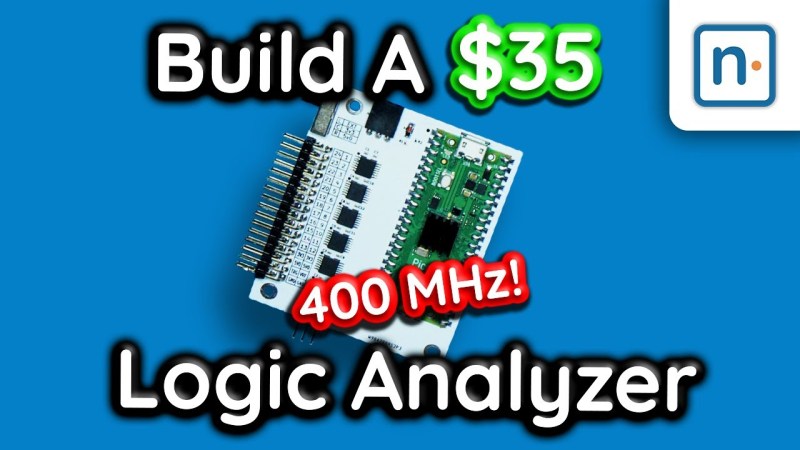What do you do when you’re a starving student and you need a 400 MHz logic analyzer for your digital circuit investigations? As [nanofix] shows in a recent video, you find one that’s available as an open hardware project and build it yourself.
The project, aptly named LogicAnalyzer was developed by [Dr. Gusman] a few years back, and has actually graced these pages in the past. In the video below, [nanofix] concentrates on the mechanics of actually putting the board together with a focus on soldering. The back of the build is the Raspberry Pi Pico 2 and the TXU0104 level shifters.
If you’d like to follow along at home, all the build instructions and design files are available on GitHub. For your convenience the Gerber files have been shared at PCBWay
Of course we have heaps of material here at Hackaday covering logic analyzers. If you’re interested in budget options check out $13 Scope And Logic Analyzer Hits 18 Msps or how to build one using a ZX Spectrum! If you’re just getting started with logic analyzers (or if you’re not sure why you should) check out Logic Analyzers: Tapping Into Raspberry Pi Secrets.
















Thank you! Love the project.
I guess now we can finally lay the good old Chinese Cypress CY7 based 24MHz (12MHz on a good day) logic analyser a good bye. It sure served me well
No, because the only usable UI is Saleae Logic. Nobody wants to use devices with bad UI.
How much is an 24 channel logic analyser from saleae again?
Is it much more than 45$?
You can also use pulseview (libsigrok based). It supports a lot of logic analysers from many different manufacturers. Also includes protocol decoders, and you can write your own.
It should be easy to adapt this project to work with it
“It should be easy to adapt this project to work with it” – Well, the original words of the author:
“Witgh Sigrok I could not implement all the special trigger capabilities that the device has, also getting any change to Sigrok in order to get the driver into it can take literally years (I know because of the project pico-analyzer).”
and
“Well, I’m sorry to disappoint you but this software will never be a replacement for Sigrok”
Nowadays any logic anaylzer with limited sample buffer that requires complex triggering and without direct streaming is mostly useless. Furthermore Pulseview is not anywhere near the UX of Saleae.
I agree on the PulseView limitations.
A partial workaround would be to capture to a binary file, which can then be used reasonably easily in PulseView by pressing the reload button after a new capture.
Pulseview absolutely never worked for me.
well, the CY7 can do that speed all day because it has highspeed USB, pico is only fullspeed so you’l be limited by memory
Pico2 can stream data over hdmi->usb3 at 175MB/s https://github.com/steve-m/hsdaoh-rp2350
Seems a perfect project would combine Macro Silicon MS2130 with couple rp2350 chips on same PCB. Streaming and 24-120 channels all in one.
I made 5 of these. I had PCBWay create the PCBs and populate them with everything except the PI Pico 2. I wanted to source the PI Pico 2 from a reputable source (TMEU.eu). In total, it cost me 90 euro for 5 boards, which is €18 a piece. €18 euro is $21, by far not $35.
I kept 2 and resold 3. The trigger of the boards can be daisy chained, so I essentially have a 48 channel logic analyzer for €36.
I use the 200MHz firmware. The 400MHz firmware has some aliasing problems, and I don’t need 400MHz for now. But a firmware update is a matter of seconds, so it doesn’t really matter. ;)
Don’t use a PI Pico 2 W, it doesn’t work. Just use the normal PI PICO 2.
The software is coming nicely together as well. Mind you, you can’t compare it to a professional multi-thousand dollar logic analyzer, although the sampling performance is great. I haven’t been going all out on the software, but I didn’t find anything about glitch detection. I’m not sure if it’s even feasible to do glitch detection in software, but the board does not have hardware glitch detection.
Also of course there is no streaming capability.
And in my price, I forgot to include shipping costs for the PICO 2’s, which was another €9. That brings the cost per analyzer to a little under €20.
But until now I was using an old Nicolet NPC-700 logic analyzer from 1982, which is a ‘luggable’ Z80-based logic analyser with 20MHz sample frequency. It weighs 15kg and makes a deafening noise. But it has 48 channels. And a keyboard and CP/M 2.2 too! ;) Kudos to the guys who made it, because it’s still working fine after 43 years, not even one exploding cap. Although I think the CRT might love a recap.
Basically, Dr. Gusman’s logic analyzer is a big improvement. If I ever need a real professional logic analyzer, I’m sure I will be able to justify the cost. But right now it’s a lot easier to justify €40 than €4000…
“Don’t use a PI Pico 2 W, it doesn’t work. Just use the normal PI PICO 2.”
Are you sure? There’s an experimental version of both the software and the firmware (6.5.0 and 6.5.1, respectively) from March 2025 in the github discussion section of the project (https://github.com/gusmanb/logicanalyzer/discussions/176) which has support for the Pico 2 W…
I don’t think you can measuring any trustable in the >100Mhz range with this funny cable-probes. You should check the cable from R&S/Hameg with integrated termination. There is a reason for that…
Olaf
I was wondering about that, too. With my good old DSLogic Pro without shielded probes I have annoying artefacts way below that frequency… Also there’s a reason Scope probes for >100MHz have low capacitance, are shielded and have grounding close to the tip. Flying leads for 200MHz? Yeah, I don’t think so…